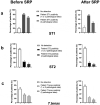Protozoans in subgingival biofilm: clinical and bacterial associated factors and impact of scaling and root planing treatment
- PMID: 31893017
- PMCID: PMC6882485
- DOI: 10.1080/20002297.2019.1693222
Protozoans in subgingival biofilm: clinical and bacterial associated factors and impact of scaling and root planing treatment
Abstract
Objective: In patients with periodontitis, identification of protozoans and evaluation of some bacteria and clinical parameters associated and assessment of scaling and root planing (SRP) impact on their detection. Methods: Before and after SRP, subgingival microbiota was collected in two pathological and one healthy site from 30 periodontitis patients. One healthy site from 30 control patients was also sampled. The usual clinical periodontal parameters were recorded; microbial detection was determined by PCR hybridization system for bacteria and qPCR for protozoans. Results: In periodontitis group, Trichomonas tenax and two subtypes of Entamoeba gingivalis (ST1 and a variant ST2) were detected in respectively 33.3%, 70% and 18.3% of pathological samples, and in 6.7%, 10% and 3.3% healthy samples. In control group, ST1 alone was found in 3.3% of individuals. ST1 was associated with Gingival Index, Clinical Attachment Level (p ≤ 0.03) and with the total bacterial count (p = 0.02). T. tenax alone was associated with P. gingivalis, T. denticola and E. nodatum (p ≤ 0,02). After therapy, only T. tenax detection decreased significantly (p = 0.004) and no association between the protozoan elimination and improvement of pathological sites was found. Conclusions: Protozoans were associated with some clinical parameters and/or periodontopathogens in patients with periodontitis.
Keywords: Entamoeba gingivalis; Trichomonas tenax; clinical periodontal parameters; periodontitis; periodontopathogens; scaling and root planing; subgingival microbiota.
© 2019 The Author(s). Published by Informa UK Limited, trading as Taylor & Francis Group.
Conflict of interest statement
No potential conflict of interest was reported by the authors.
Figures
References
-
- Trim RD, Skinner MA, Farone MB, et al. Use of PCR to detect Entamoeba gingivalis in diseased gingival pockets and demonstrate its absence in healthy gingival sites. Parasitol Res. 2011;109:857–13. - PubMed
-
- Ghabanchi J, Zibaei M, Daguighafkar M, et al. Prevalence of oral Entamoeba gingivalis and Trichomonas tenax in patients with periodontology disease and healthy population in Shiraz, Southern Iran. Indian J Dent Res. 2010;21:89–91. - PubMed
-
- Feki A, Molet B, Haag R, et al. Protozoa of the human oral cavity (epidemiological correlations and pathogenic possibilities). J Biol Buccale. 1981;9:155–161. - PubMed



